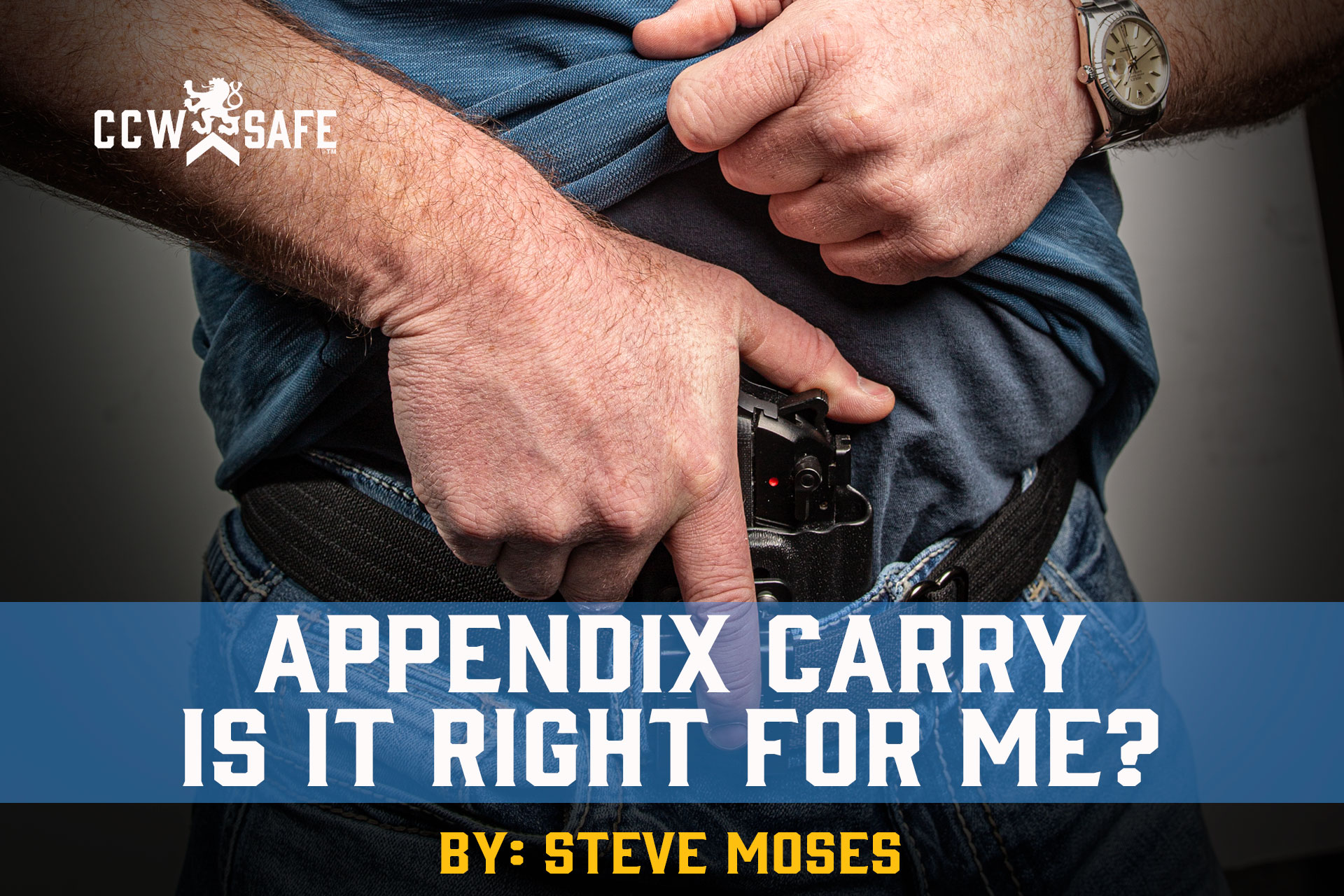
Posted on July 1, 2019 by Steven Moses in Training
Is Appendix Carry Right for You?
Is Appendix Carry Right for You?
The traditional holster position for both law enforcement and concealed carriers has almost always been on the strong-side hip. There are multiple reasons for this, including ease of concealment for concealed carriers wearing coats and vests, as well as the speed of presentation. I carried this way for years, and still do as a reserve deputy, or while wearing a suit or sport coat.
Some time ago, I learned about the concept of appendix carry. This method calls for wearing the holster inside the waistband, just forward of the hip joint. I initially reacted with horror to this carry method. I imagined my pistol discharging while pressed against my groin.
Over time, I warmed up to appendix carry. After participating in Craig Douglas’ Extreme Close Quarters Contact course, his Vehicle Combatives and Shooting Tactics course, and Cecil Burch’s Immediate Action Jiu-Jitsu course, I reconsidered my appendix carry position.
In my opinion, it’s easier to get a concealed pistol into play with the appendix carry position. This includes pretty much any conflict scenario I was ever in. It’s easier for me to conceal a pistol with appendix carry when wearing a tee shirt or an untucked camp shirt.
Appendix Carry Holsters and Instruction
What sealed the deal for me was a class in Appendix Carry with Spencer Keepers. Spencer was something of a pioneer when it came to designing a robust, comfortable-to-wear holster that’s fast to draw from. His holsters are easy to conceal under a light shirt, have good retention qualities, and are safe to use if the concealed carrier is disciplined and properly trained.
Many concealed carriers who’ve tried appendix carry found it uncomfortable. Part of the reason here is that some holster makers did little more than attach belt loops, or a clip, to the outside of a traditional strong-side holster – then marketed it as an “appendix carry” holster.
In many instances, the sharp edges of these less-than-optimal holsters abraded the skin forward of the hip joint. The front strap of the handgun butt was too close to the belt, which left insufficient room to acquire a good firing grip without first scraping the fingers over the top of the belt. Not comfortable at all.
Appendix Carry and Negligent Discharges
A common cause of negligent discharges is a failure on the shooter’s part to remove the finger from the trigger before holstering. If a handgun is holstered while the shooter’s finger is on the trigger, the gun can fire when that finger makes contact with the top of the holster. While significant injury can result to a standing shooter with strong-side carry or appendix carry, the possibility of death increases significantly should the concealed carrier attempt to insert the handgun into an appendix holster while seated. The muzzle might be located directly over the femoral artery.
I’ve found that appendix carry holsters made by Spencer Keepers and appendix carry Kydex holsters make holstering with the index finger on the trigger difficult. The front side of the holster comes up high on the pistol. The user will typically find that the narrow top edge of the front side of the holster digs painfully into the finger before the pistol can be fully seated – which is a strong indication that the concealed carrier has committed one, if not two, major safety infractions.
If it’s necessary to holster from appendix carry while seated in a vehicle, the concealed carrier should straighten his or her legs out as much as possible. Lean back in the seat and raise the pelvis as high as possible, then carefully holster, paying full attention to the task at hand. I usually push the muzzle of my pistol away from the body as soon as the muzzle enters the holster, just to achieve some additional offset.
A well-designed appendix carry holster is comfortable for most people to wear and comes with some advantages over strong-side carry in certain situations. Holstering while seated requires strict discipline and attention to detail. Under no circumstances would I encourage a concealed carrier comfortable with strong-side carry to make the switch simply for the sake of change.
I’ve discovered that the ability to carry in the appendix carry position and with a strong side carry holster both have benefits, depending on what the occasion dictates, and how I dress.
 |
Steve MosesSteve is a long-time defensive weapons instructor based out of Texas who has trained hundreds of men and women of all ages for more than two decades on how to better prepare to defend themselves and their loved ones. Steve has completed over 80 private-sector and law enforcement-only defensive weapons and tactics classes, and has trained civilian and law-enforcement officers in six states. Moses is a reserve deputy, former member of a multi-precinct Special Response Team, competitive shooter, and martial artist. Steve has written numerous articles for SWAT Magazine and other publications. Steve is a licensed Texas Level 4 Personal Security Officer and Instructor who was Shift Lead on a mega-church security detail for seven years, and has provided close protection for several former foreign Heads of State. He is currently an instructor at Relson Gracie Jiu Jitsu/Krav Maga in Tyler, Texas and Director of Training for Palisade Training Group (www.ptgtrainingllc.com). |